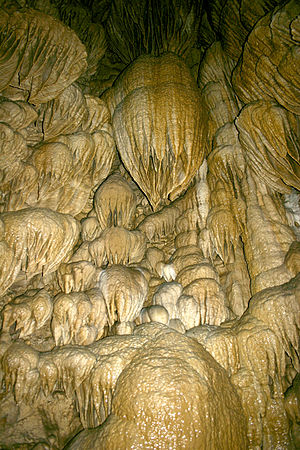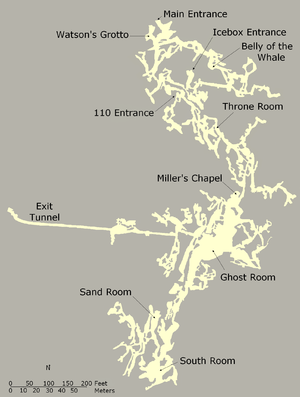Oregon Caves National Monument and Preserve
| Oregon Caves National Monument and Preserve | |
| U.S. National Monument | |
|
Formations resembling drapery in a dome-shaped pit in Oregon Caves
|
|
| Country | United States |
|---|---|
| State | Oregon |
| County | Josephine |
| City | Cave Junction |
| Cave entrance | About 20 miles (32 km) east of Cave Junction |
| - elevation | 4,377 ft (1,334 m) |
| - coordinates | 42°05′44″N 123°24′21″W / 42.09556°N 123.40583°WCoordinates: 42°05′44″N 123°24′21″W / 42.09556°N 123.40583°W |
| Highest point | |
| - elevation | 5,480 ft (1,670 m) |
| Area | 4,558 acres (1,845 ha) |
| Geology | Solutional cave in marble |
| Established | July 12, 1909 |
| Management | National Park Service |
| Visitation | 72,709 in 2015 |
|
Map of the cave
|
|
| Website: Oregon Caves National Monument and Preserve | |
Oregon Caves National Monument and Preserve is a protected area in the northern Siskiyou Mountains of southwestern Oregon in the United States. The main part of the 4,558-acre (1,845 ha) park, including the marble cave and a visitor center, is 20 miles (32 km) east of Cave Junction, on Oregon Route 46. A separate visitor center in Cave Junction accounts for 4 acres (1.6 ha) of the total. Both parts of the monument, managed by the National Park Service, are in southwestern Josephine County, near the Oregon–California border. The climate is generally mild even at the cave's elevation of about 4,000 feet (1,200 m) above sea level, but icicles can form at the cave entrance, and winter snow sometimes blocks the park highway.
Elijah Davidson, a resident of nearby Williams, discovered the cave in 1874. Over the next two decades, private investors failed in efforts to run successful tourist ventures at the publicly owned site. After passage of the Antiquities Act by the United States Congress, President William Howard Taft established Oregon Caves National Monument, to be managed by the United States Forest Service, in 1909. The popularity of the automobile, construction of paved highways, and promotion of tourism by boosters from Grants Pass led to large increases in cave visitation during the late 1920s and thereafter. Among the attractions at the remote monument is the Oregon Caves Chateau, a six-story hotel built in a rustic style in 1934. It is a National Historic Landmark and is part of the Oregon Caves Historic District within the monument. The Park Service, which assumed control of the monument in 1933, offers tours of the cave from mid-April through early November. In 2014, the monument was expanded by about 4,000 acres (1,600 ha) and re-designated a National Monument and Preserve. In addition, the River Styx, which flows through the cave and emerges as Cave Creek, was named to the National Wild and Scenic Rivers System.
...
Wikipedia



